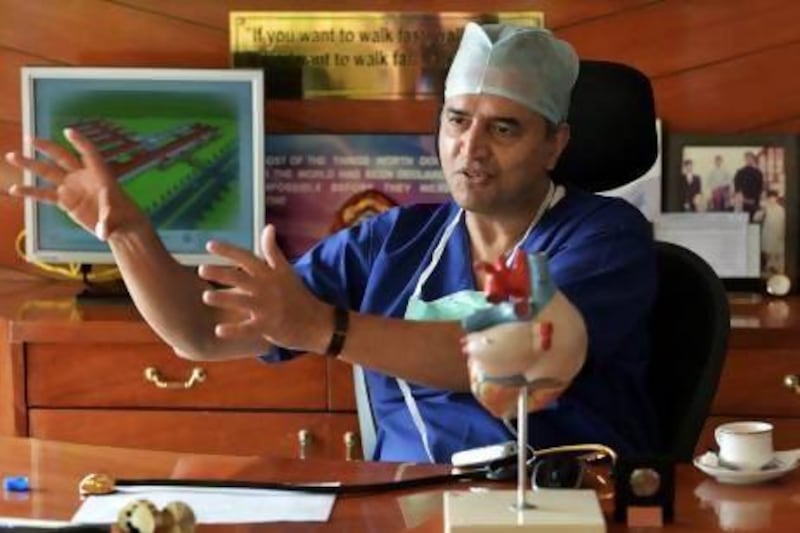MUMBAI // Devi Shetty is obsessed with making heart surgery affordable for millions of Indians. On his office desk are photographs of two of his heroes: Mother Teresa and Mahatma Gandhi.
Mr Shetty is not a public health official motivated by charity. He is a heart surgeon turned businessman who has started a chain of 21 medical centres around India. By trimming costs with such measures as buying cheaper scrubs and spurning air- conditioning, he has cut the price of artery-clearing coronary bypass surgery to US$1,583 (Dh5,814), half of what it was 20 years ago, and wants to get the price down to $800 within a decade. The same procedure costs $106,385 at Ohio's Cleveland Clinic, according to data from the US Centers for Medicare & Medicaid Services.
"It shows that costs can be substantially contained," said Srinath Reddy, president of the Geneva-based World Heart Federation, of Mr Shetty's approach. "It's possible to deliver very high quality cardiac care at a relatively low cost."
Medical experts like Mr Reddy are watching closely, eager to see if Mr Shetty's driven cost-cutting can point the way for hospitals to boost revenue on a wider scale by making life-saving heart operations more accessible to potentially millions of people in India and other developing countries.
"The current price of everything that you see in health care is predominantly opportunistic pricing and the outcome of inefficiency," Mr Shetty, 60, said.
Cutting costs is especially vital in India, where more than two-thirds of the population lives on less than $2 a day and 86 per cent of health care is paid out of pocket by individuals. A recent study by the Public Health Foundation of India and the London School of Hygiene & Tropical Medicine found that in India non-communicable ailments such as heart disease are now more common among the poor than the rich.
Heart disease is the number one killer in India and per capita health spending is less than $60 a year. Yet the country performs only 100,000 to 120,000 heart surgeries each year, well short of the 2 million Mr Shetty estimates are needed. The mortality rate from coronary artery disease among South Asians is two to three times higher than that of Caucasians, according to a study published in 2008 in the journal Vascular Health and Risk Management.
"There has been fast urbanisation in India that has brought with it a change in dietary patterns and lifestyle," said Usha Shrivastava, head of public health at the National Diabetes, Obesity and Cholesterol Foundation. "It's leading to this huge jump in cardiovascular disease."
The average age for a first heart attack in India, Pakistan and other South Asian nations was 53 years, compared with 58.8 years in countries outside the region, according to a study published in 2007 in the Journal of the American Medical Association.
The biggest impediment for heart surgery in India is accessibility. Mr Shetty aims to bridge that by building hospitals outside India's main cities. He said he plans to add 30,000 beds over the next decade to the 6,000 the hospital chain has currently, and has identified 100 towns with populations of 500,000 to 1 million that have no heart hospital.
A 300-bed, prefabricated, single-story hospital in the city of Mysore cost $6 million and took six months for construction company Larsen & Toubro to build, Mr Shetty said. Only the hospital's operating theatres and intensive-care units are air-conditioned, to reduce energy costs.
One of the ways in which Mr Shetty is able to keep his prices low is by cutting out unnecessary pre-op testing, he said.
Urine samples that were once routine before surgery were eliminated when it was found that only a handful of cases tested positive for harmful bacteria. The chain uses web-based computer software to run logistics, rather than licensing or building expensive new systems for each hospital.
When Mr Shetty could not convince a European manufacturer to bring down the price of its disposable surgical gowns and drapes to a level affordable for his hospitals, he convinced a group of young entrepreneurs in Bangalore to make them so he could buy them 60 per cent cheaper.
In the future, Mr Shetty sees costs coming down further as more Asian electronics companies enter the market for CAT scanners, MRIs and catheterisation labs — bringing down prices. As India trains more diploma holders in specialities such as anesthesiology, gynaecology, ophthalmology and radiology,
One positive unforeseen outcome may be that many of the cost-saving approaches could be duplicated in developed economies, especially in the US under health reform.
"Global health care costs are rising rapidly and as countries move toward universal health coverage, they will have to face the challenge of providing health care at a fairly affordable cost," said the World Heart Federation's Mr Reddy, a New Delhi-based cardiologist who is also president of the Public Health Foundation of India.





